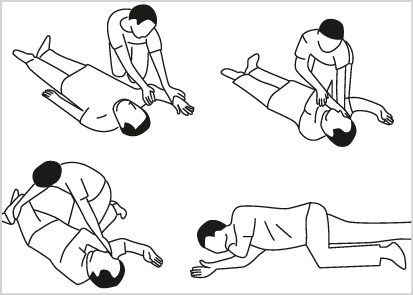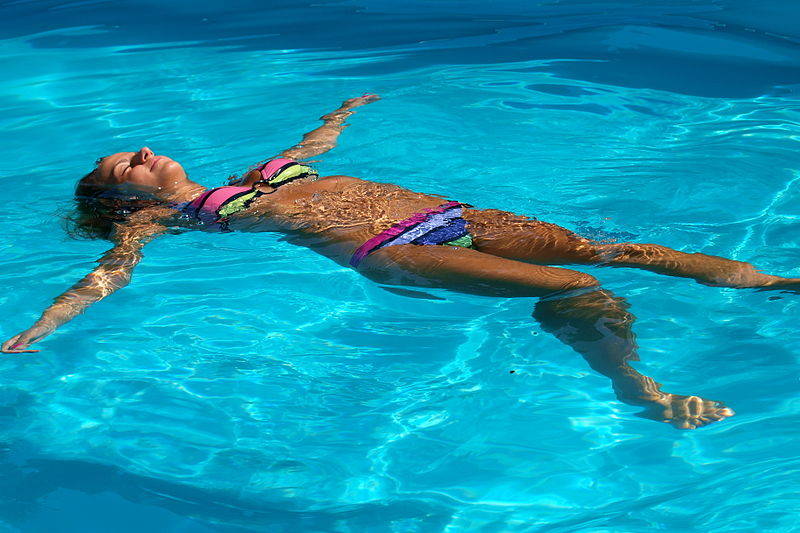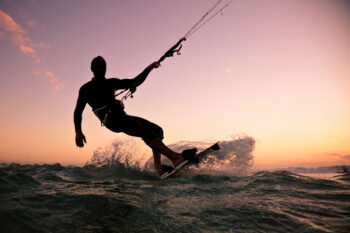
First aid on the water. How to help someone drowning at sea? Manual and rescue grips.
Holidays by the sea are associated with blissful relaxation. However, it may happen that a carefree relaxation on the beach is interrupted by an unexpected event and the need to provide first aid to a drowning person who is engaged in an unequal struggle with the element. We advise on how to behave when we spot a drowning person, how to get a drowning person out of the water and how to properly provide first aid to a drowning person.
Knowing the basic principles of first aid over water and how to behave in a dangerous situation can save the life of a drowning person and those who start drowning themselves. This text is a must read before going on vacation to the seaside.
How many people are killed because of drowning?
Drowning statistics are ruthless ... Drowning is the third leading cause of unintended death worldwide. According to WHO data, as many as 360,000 people die every year in the world from drowning. Poland is at the forefront of other European Union countries. According to the statistics kept by the Water Police, proportionally twice as many people die in our country than in other EU countries. In 2019 alone, 456 people lost their lives in this way, and in 1998-2018, 12,100 people drowned in Poland. As many as 22% drowned people were under the influence of alcohol. Most drownings are recorded in rivers and lakes (62% in total), the least (6%) people are drowned in the sea. This does not mean, however, that we are completely safe when relaxing on coastal beaches.

The drowning man does not scream! How to recognize if someone is drowning?
Being on the shore of the reservoir, we do not pay attention to what is happening in the water, assuming that a person in trouble will alert us in the event of an emergency. Nothing could be more wrong! Remember that a person who is drowning does not scream. The water in the mouth and entering the lungs effectively prevents a drowning person from calling for help.
If you see a person swinging their arms vigorously, unable to control their movements, disappearing under water and reappearing, or drifting in an unnatural position without moving for an extended period of time, a rescue operation may be needed.
You should then shout loudly and ask if you need help. If we do not hear an answer, proceed immediately.
REMEMBER! You are not responsible for not helping someone drowning in water. Never attempt a water rescue if you cannot swim by yourself, are afraid of the water, or do not feel strong enough. Also, do not enter the water while under the influence of alcohol or drugs. Being intoxicated you are only apparently the strongest man in the world.
What to do when we spot a drowning person?
Once we identify a person who needs help, do not panic and do not play the hero by force. It should be remembered that a person who drowns is a threat to the rescuer. Regardless of whether the person providing help is a trained specialist or an ordinary amateur, providing help requires a confrontation with a dangerous element and the injured, with whom normal contact cannot be established, panicked and irrational. We must therefore remain calm and take care of our own safety, so that the rescue operation does not end in a double tragedy.
- First of all, alert other people nearby, informing loudly about the person in the water who needs help. In this way, we will draw the attention of third parties who may be able to help us. It may turn out that there is a paramedic or doctor among other sunbathers. Their help can be invaluable.
- Equally quickly, before starting any rescue operation, you should call for help by calling an ambulance. You can do it yourself or ask someone around you. Keep calm while informing the emergency room about the event, let's say what is happening, how many people need help, and where are we. When entering the beach, remember to pay attention to the number on the plates placed at each entrance. This seemingly insignificant detail will significantly reduce the time it takes for emergency services to arrive.
- When on a guarded beach, you must immediately call a lifeguard. It is better to wait a few seconds for a specialist's reaction than to risk it yourself.
REMEMBER! The emergency numbers to use on the water are 601 100 100 and 984. You can also call 112 at any time.
How to get a drowning person out of the water?
Once the alarm is raised, assess the situation and choose the most appropriate method to get the drowning person out of the water. If you cannot swim and the victim is far from the shore, you must rely on the help of others.
- When helping from the shore, first provide a pole, oar, branches, some clothes. Only when it is impossible to get out of the shore should you enter the water.
- If possible, let's build a help chain. It is created with the participation of several people holding hands. In this way, you can drag a drowning person ashore in a relatively safe way. We have constant physical contact with the person taking part in the action.
- Giving the drowning person your own hand is not recommended. We only use equipment as a last resort. A person who drowns has a very strong and unconditional grip and can pull the rescuer under the water. You can also use a boat, pontoon, mattress, surfboard or other floating equipment.
- After entering or jumping into the water, we swim to the drowning person and stop beyond the reach of his arms. Most often, the shock of drowning is so great that you won't be able to make contact, but try it. Often a drowning person, seeing a lifeguard within arm's reach, can control himself; however, we do not expect that it will happen.
- If it is not possible to calm a drowning person, overwhelm him with a firm and firm grip from behind. Holding the injured from behind, under the armpits and swimming on the back, we support him with both hands. One hand is enough for swimming on the side. If the drowning person is wearing clothes, you can grab him by his clothes on his back. When a drowning person goes under the water and cannot be caught, without fear of damaging his body, grasp him firmly by the hair and pull him to the surface. After properly catching the unfortunate, slowly tow him to the shore.
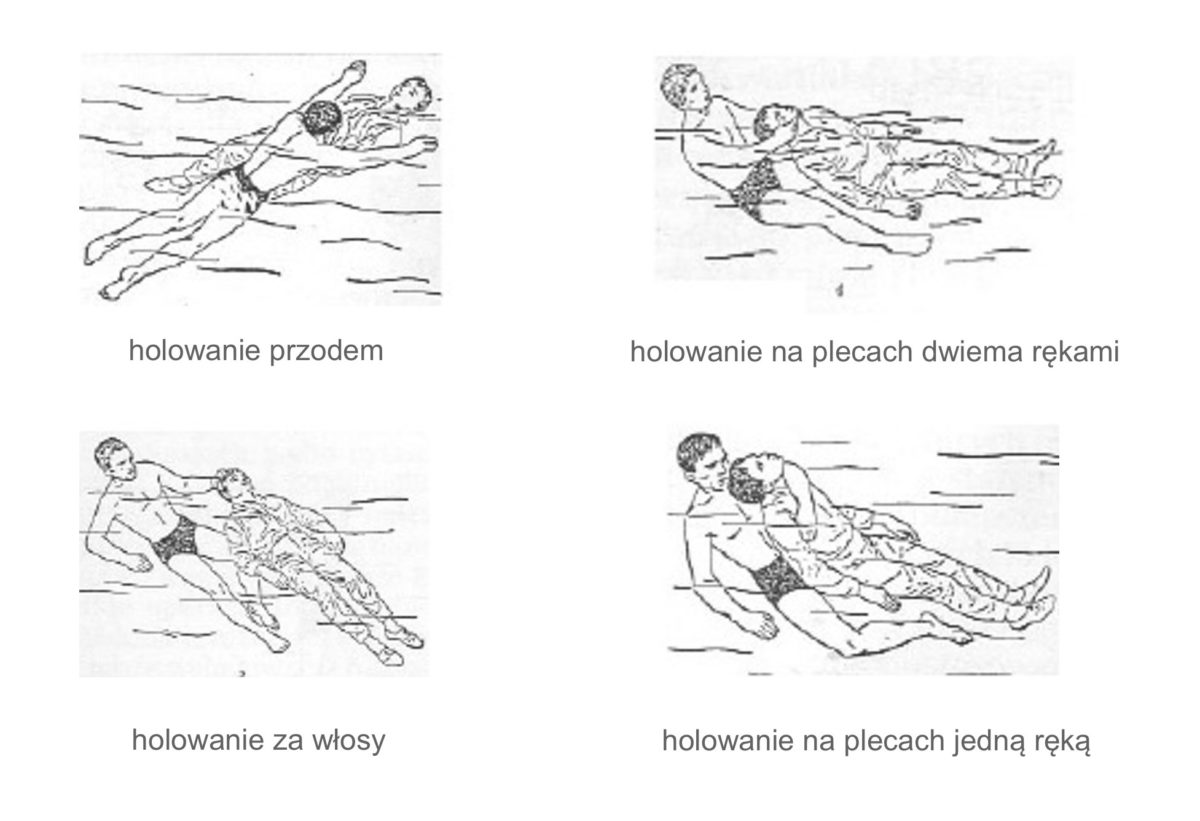
What to do when we start to sink ourselves?
When entering the water, we very often behave in a daring manner, wanting to show how well we deal with the element. Remember that water is always stronger than man. Don't show off to your friends! Do not bathe while drunk, even if you think you are in control of the situation - you are out of control, this is apparent strength. Do not jump on the head and stay away from the shore. Do not bathe in solitude and choose guarded beaches.
If you find yourself in a difficult situation, keeping a cool head may save your life:
- Don't panic. Losing control of the situation will only accelerate the drowning process.
- Lie on your back, spread your arms and legs to your sides. Your body will easily rise and be kept on the surface of the water.
- Breathe calmly and evenly. If you choke on water, take a calm and deep breath through your nose and cough hard.
- Swim to shore or call for help. If you stay calm, you can easily reach the shore on your back using only your arms or legs. If you control the shock, you can also call for help.
REMEMBER! The more part of your body is submerged, the better your buoyancy will be. Conversely, when you lift your limbs up, your buoyancy will decrease and your head will automatically begin to descend.
Resuscitation of the unconscious on the shore
- After an unconscious person is pulled ashore, it should be checked that there are no foreign bodies in the respiratory tract. To do this, place the patient in a supine position and examine the airway for patency. If there are foreign bodies in the nose or mouth, remove them.
- Check if the injured is breathing. Put your face to his face. Watch your chest or place your hand on it. If you cannot feel or hear your breath and your chest does not rise, tilt his head back and start CPR:
- Kneel next to the injured person,
- Place the wrist of one hand in the center of the victim's chest,
- Place the wrist of the other hand on the one already placed,
- Clasp the fingers of both hands and make sure that you do not put pressure on the ribs of the injured person; do not put pressure on the abdomen or the lower end of the breastbone,
- Lean over the injured person, place your straight arms perpendicular to the sternum and put pressure on them 4-5 cm,
- After each compression, release the pressure on the chest without taking your hand off the sternum. Repeat compressions with a frequency of 100-120 per minute (slightly less than 2 compressions / s),
- The period of compression and release of pressure on the sternum should be the same.
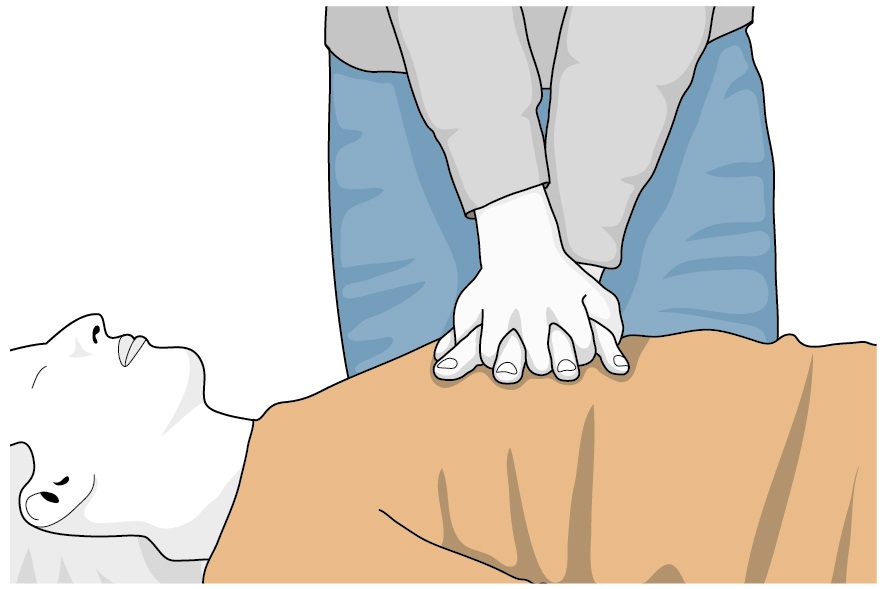
Continue CPR until the victim begins to breathe properly or until qualified medical personnel arrive and take action.
Resuscitation of a drowning person
- In shallow waterclose to shore, give five rescue breaths and swim to shore as quickly as possible.
- In deep waterwhen we are able to perform rescue breaths, we should give them for a minute which gives us 10-15 breaths.
If normal breathing does not return and the towing time to shore does not exceed 5 minutes, breathe while towing if possible. On the other hand, when we are far from land with the victim, after a minute of ventilation, swim with the victim to the shore as soon as possible and, if necessary, continue resuscitation according to the principles described earlier.
Safe side position
- Kneel on one side of the injured person and straighten his legs;
- Place the victim's hand on your side in a 90-degree bend in the shoulder and elbow joints. When the elbow is bent, the hand should be placed upwards;
- Put the victim's other hand across his chest and the back of his hand under his cheek.
- Grasp the injured person's leg above the knee and pull it upwards without lifting the foot off the ground.
- Pull the leg so that the injured person turns sideways towards you.
- After turning the casualty, position the upper leg so that the hip and knee flexion is 90 degrees.
- Gently tilt the victim's head back to ensure that air can flow freely through the respiratory tract.
- Constantly monitor the respiratory system of the injured person. You can also cover it with a dry towel or blanket.
